MXA RACE TEST: 2017 HUSQVARNA TX300 — CROSS-COUNTRY & MX
Click on images to enlarge
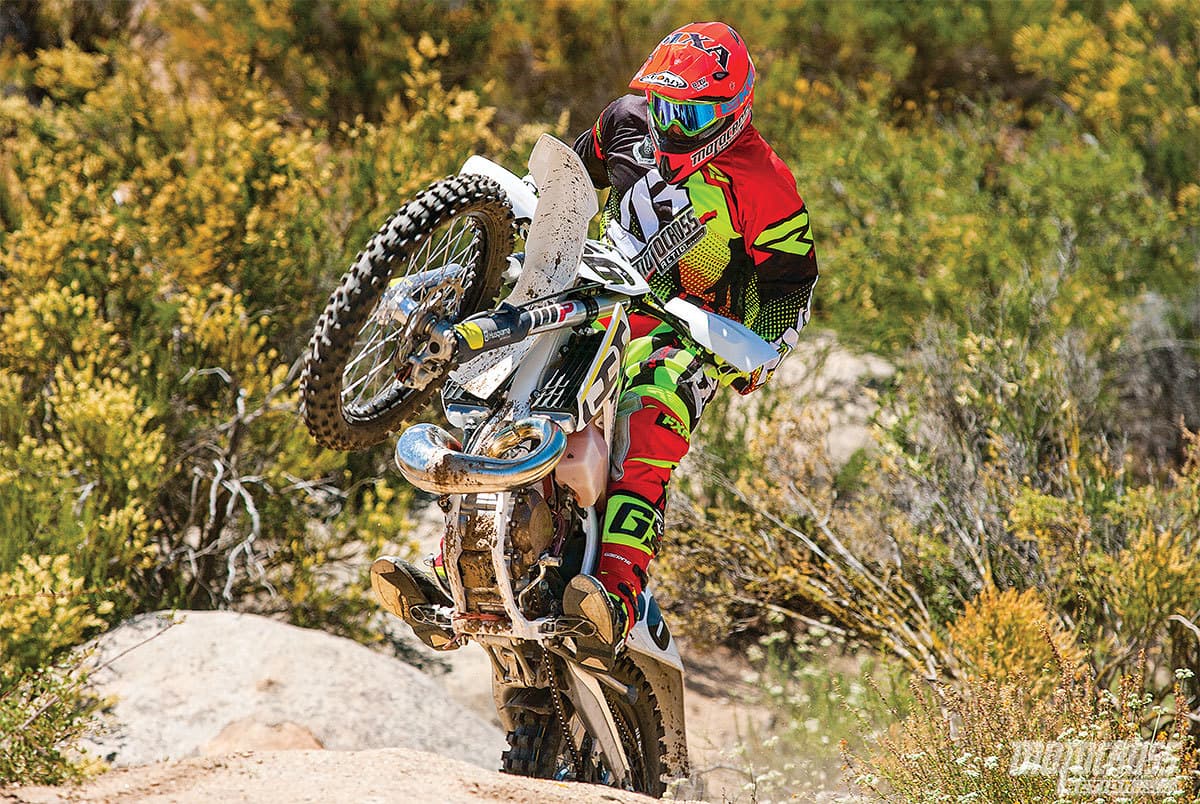
Q: FIRST AND FOREMOST, IS THE 2017 HUSQVARNA TX300 BETTER THAN THE 2016 TX300?
A: Yes. Not just because there wasn’t a TX300 last year, but because this is a totally new chassis, engine, drivetrain and ergos package for 2017.
Q: WHY IS MXA TESTING AN ENDURO BIKE?
A: We are not an offroad magazine, nor are we interested in testing offroad bikes for their intended use; however, MXA is always interested in testing offroad bikes on motocross tracks. We’ll race anything with an engine and two wheels—and we approach offroad bikes with an eye towards their ability to be used not just for trail riding but for motocross. In the past we have tested the YZ250X, YZ450FX, YZ250FX, KTM 300XC and even the XR650, XR400, KLX250 and KLX300 all on motocross tracks. Interestingly enough, each of these bikes featured something we liked better than what was on their motocross counterparts. The electric start of the Yamaha YZ450FX was a hit. The closer gear ratios between second and third on the Yamaha YZ250X allowed for a faster transition to fourth. The YZ250FX’s nine-plate clutch allowed for softer clutch springs, which meant a softer pull at the lever.
It should come as no surprise to anyone in the market for an offroad bike that the best place to start is with a motocross bike. All of the current crop of modern, updated 2017 offroad bikes are cut from the same cloth as their motocross brothers. They use the same engines, chassis, running gear and components. The differences are almost always limited to wide-ratio transmissions, heavier flywheel weights, mellower ECU settings, softer suspension, bigger gas tanks and kickstands.
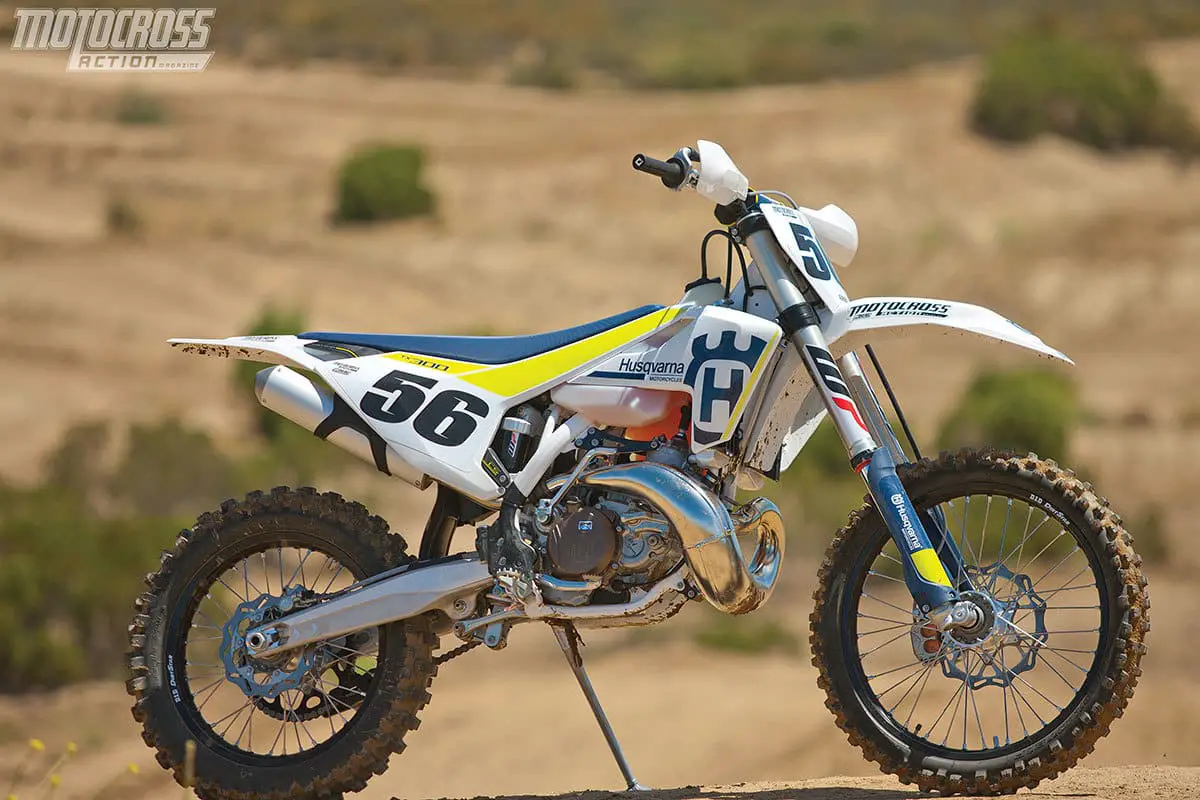
In the past we have tested numerous KTM 300cc two-strokes. Since KTM only makes the offroad 300XC and it comes with a wide-ratio six-speed transmission, big gas tank, electric starter and added enduro bulk, it was a yawn for the wrecking crew. We found it less expensive and more efficient to transform our 250SXs into 300SXs with KTM’s bolt-on 300cc engine kit. A full-race 300SX was eye-watering to hang on to, and we loved the adrenaline rush, despite our arms pumping up like Popeye’s.
For 2017 the KTM 250SX and Husqvarna TC250 twins came out swinging. With the twins equipped with new engines, it felt like we were riding the powerful KTM 300SXs we built years ago, although lighter, better handling and vibration-free. The twins are too hot for many to handle. We have spent considerable time toning down their midrange hit, which is much cheaper and easier than hopping them up.
Since the Husqvarna TX300 two-stroke is built on the bones of the 2017 TC250, but with an easier-to-ride and mellower powerband, we thought it might be the ultimate two-stroke motocross bike as well as a great trail bike. Was the TX300 the answer?
Q: WHAT ARE THE DIFFERENCES BETWEEN THE TC250 AND THE TX300?
A: There are eight major differences between Husky’s purpose-built TC250 motocross bike and the TX300 offroad bike.
(1) Kickstand. Riding around with a kickstand on a motocross track is kinda like having a granny cord on your reading glasses. They are both convenient to use, but the fashion police will throw you in the slammer. We like them; we just don’t like being seen with them.
(2) Fuel tank. The TX300 gas tank holds 2.65 gallons, while the TC250 holds 1.85 gallons. That is almost 6 pounds of extra weight. Husky was smart enough to design its offroad tank so that the bulk of the extra fuel is placed lower on the frame (and none of it higher).
(3) Wheel. The 18-inch rear wheel of the TX300 is an essential feature on an offroad machine. The bigger sidewalls increase absorption and traction over rocks, tree roots and offroad obstacles. For motocross use, the bigger 18-inch profile is bouncy in the whoops and a little draggy-feeling on the exit of hard-packed turns. On the plus side, the larger volume of the 18-inch rear tires makes the suspension feel plusher in the bumps.
(4) Displacement. It was clever of KTM and Husky to develop different models with many of the same parts. This kept the production costs at a minimum. To make the TC250 into a TC300, it only takes a handful of parts—in large part because the two displacements share the same stroke. KTM and Husqvarna will offer kits to turn the TC250 and 250SX into a TC300 or 300SX.

(5) Gearbox. Although the final ratios of first through fifth gear are similar on the TC250 and TX300, on the track they feel vastly different. The spread between second and third feels much further apart on the TX300. Given that MXA test riders complained that second and third on the 2017 TC250 were too close together, the feel of the TX300 hits the spot. Hold on. Does that make sense? Since the ratios are almost identical, why did the TX300 feel like it had a more usable gap between gears? The answer? A heavier flywheel weight and different mapping. As for sixth gear on the TX300, we never got there on a motocross track—or on the freeway heading to the track.
(6) Electric starter. Regardless of the added weight, we love the electric starter on the TX300. We wish the TC250 came with it also.
(7) ECU. The ECUs are identical pieces of hardware on both bikes, but the maps inside them are different. Unfortunately, you can’t convert your a TC250 black box to a TX300 black box if you go for the big-bore kit. No sweat. The TX300 black box is included in the 300cc upgrade engine kit.
(8) Flywheel. The heavier flywheel on the TX300 gets the power to the ground. It mellows out the powerband, which makes it easier to work with in motion. The heavier flywheel is something that would also add more dimension on the stock 2017 TC250 and KTM 250SX. Contact Steahly at www.steahlyoffroad.com for available flywheel options.
“TEST RIDERS ARE ALWAYS LOOKING FOR MORE POWER—THIS WAS THE FIRST BIKE THEY THOUGHT WAS FAST ENOUGH.”
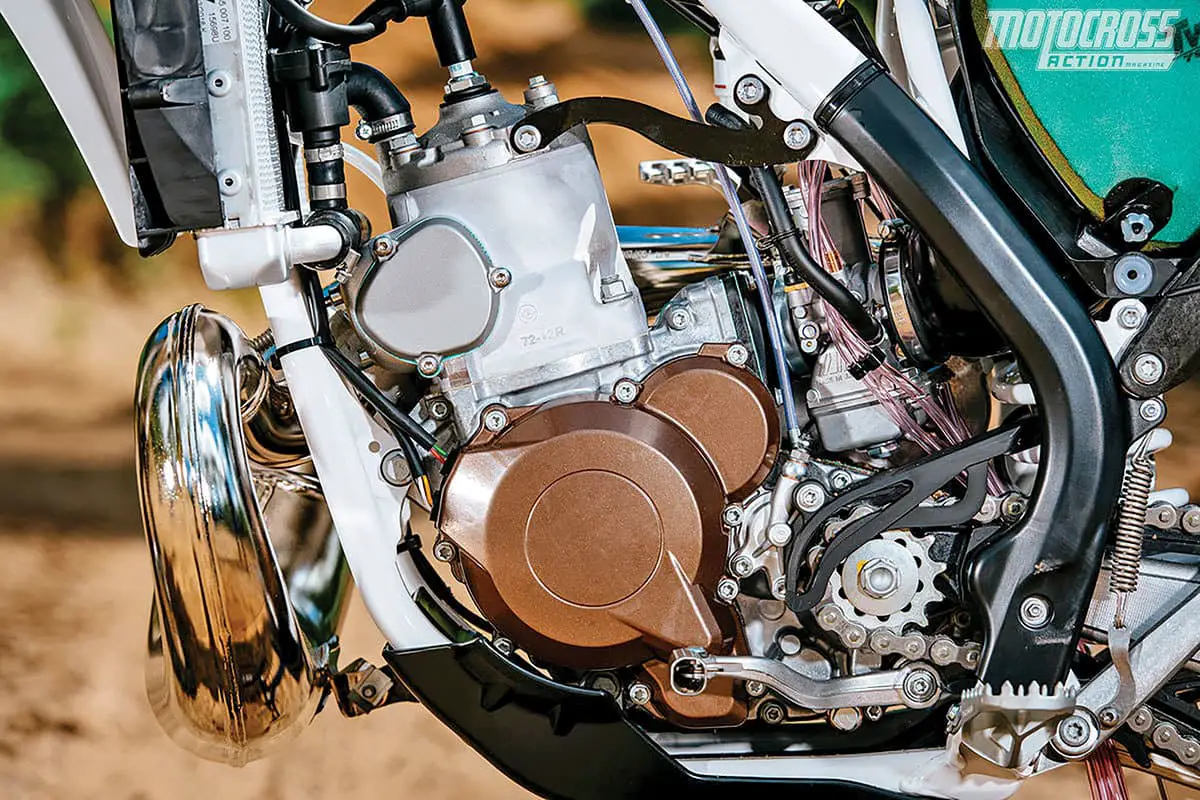
Q: WHAT IS THE 2017 HUSQVARNA TX300’S POWERBAND LIKE?
A: In one word, smooth—so smooth it catches you off guard. This is an engine that makes you feel as if you are going slower than you actually are. The linear powerband has no hit—and our testers like it that way. We tried going in on the power-valve adjuster to give the engine more grunt. This made it feel like a traditional 300, which means that it wanted to fall off the map at peak rpm. It was harder-hitting when the power valve was turned in, but it required more work on the rider’s part. The rear end would break loose quicker, and the suspension became more erratic because of the extra burst.
The TX300’s smooth, easy-to-ride, broad powerband gets the power to the ground, unlike the more abrupt TC250 and 250SX. The rear end sticks like glue thanks to the heavier flywheel and mellower ECU settings. It has the effect of traction control. Every MXA test rider clicked up to third gear and twisted the throttle to the stops; the powerband did the rest. It was awesome to go fast with virtually no effort. We will admit that our younger test riders thought the powerband was a buzzkill. Their adrenaline gauge was set to the Clearasil setting.
Q: HOW DOES THE 2017 HUSQVARNA TX300 HANDLE?
A: In spite of the 15 extra pounds compared to the TC250 (due to the over-sized tank, six-speed gearbox, electric starter, battery and kickstand), you don’t feel it as much as you would think. We noticed the added weight in flight and when cranking the bike over in tight turns. The linear power helped the handling by taking the jerks and jolts out of throttle changes. The mellow, lugging power made for a super-smooth ride.
With the exception of the added weight, this is a very solid two-stroke handling package. It is stable as a rock at speed, carves through corners without a hint of understeer, and feels flat and level in the rough.
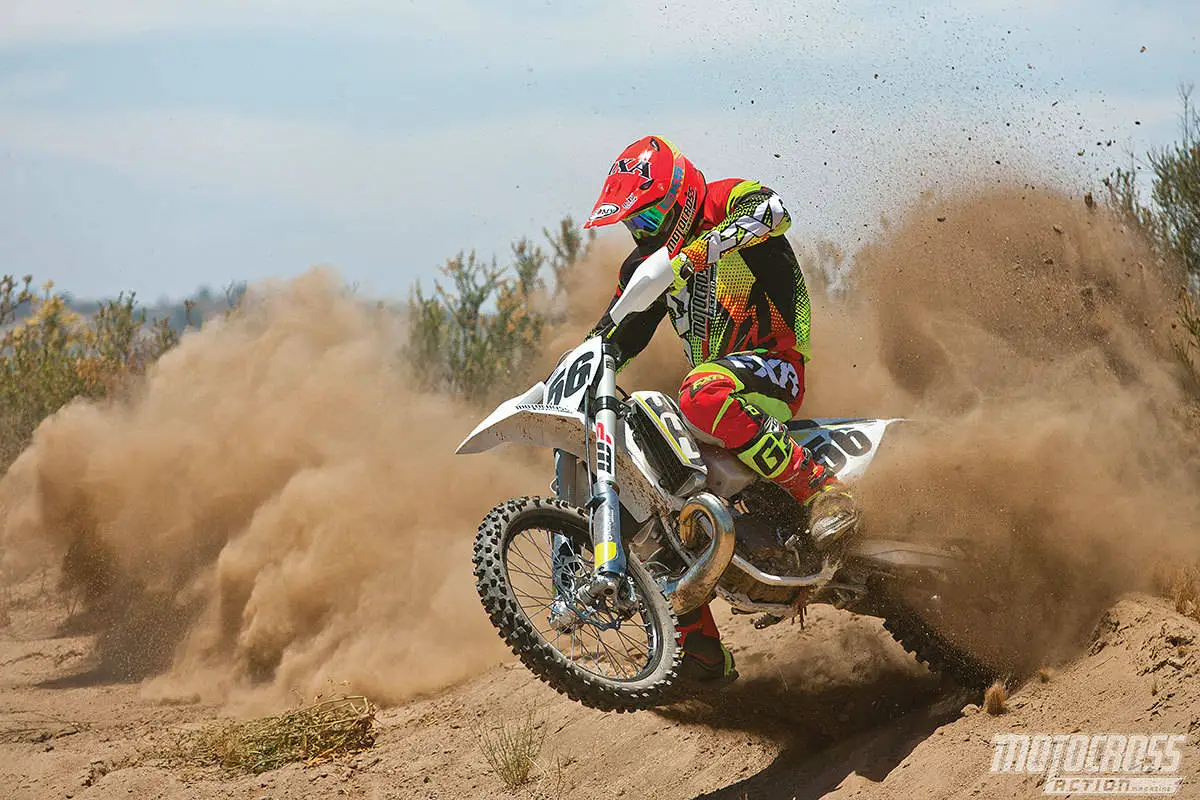
Q: HOW DID THE OFFROAD SUSPENSION SETTINGS HANDLE A MOTOCROSS TRACK?
A: The great thing about the new AER air fork is that you can make it as stiff as you want. The recommended stock TX300 air pressure is 139 psi. It felt like we were riding on clouds with marshmallow bumps at this pressure. The rougher the track got, the more we pumped up the forks. For motocross, we settled on 150 psi. Because of the offroad damping specs, the forks were still soft on big hits, but the WP AER forks handled Glen Helen better than any offroad fork we have ever tested.
The shock had a lot of movement, which is the norm for an offroad setting. We liked it for high-speed sections under acceleration, but in turns the rear end would dip down further than we would have liked. For double duty, some offroad riding and some motocross, we’d leave it alone because it is great offroad and passable on a racetrack.
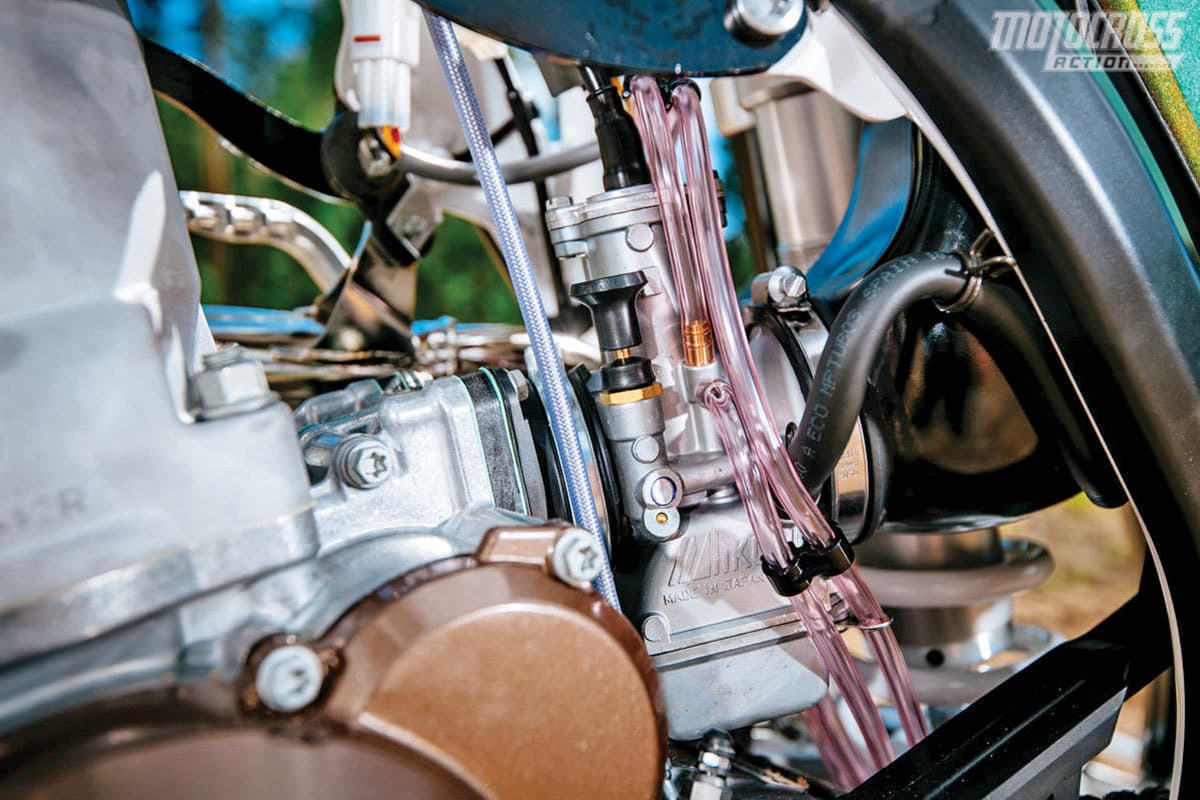
Q: WHAT DO WE REALLY THINK?
A: The TX300 is a versatile machine. We can’t be overly critical of a bike that was designed for offroad riding that we tested on motocross tracks. We have nothing but praise for the Husqvarna TX300. The semi-close-ratio gearbox, added cubic centimeters, versatile air fork and accurate handling allow the TX300 to handle the rigors of motocross quite well. Test riders are always looking for more power from every bike they test; this is the first bike they thought was fast enough. More power would only ruin a powerband that lets you go faster with less stress on your mind and body. Hardcore motocross racers could learn a thing or two from this offroad bike.
MXA’S HUSQVARNA TX300 SETUP SPECS
This is how we set up our 2017 Husky TX300 for racing. We offer it as a guide to help you find your own sweet spot.
WP AER FORK SETTINGS
These settings are for riders who want to take their TX300 onto the motocross track and live to tell about it. The stock 139-psi air pressure works like a dream in offroad conditions but not on a motocross track. The first thing you need to do is raise the fork’s air pressure. Most MXA test riders felt that 150 psi was the sweet spot. Any lower and the big hits blew through the travel. For hard-core racing we recommend this fork setup for the 2017 Husqvarna TX300 (stock settings in parentheses).
Air pressure: 150 psi (139 psi)
Compression: 15 clicks out (12 clicks out)
Rebound: 6 clicks out (12 clicks out)
Fork-leg height: Second line
Notes: Don’t worry about checking the WP AER forks’ air pressure each and every time you hit the track. Do, however, bleed both of the air screws on the top of the forks. Don’t use a #20 Torx to unthread the air side’s bleed screw; it will strip. Use a 10mm T-handle on the right leg (you have to use a #20 Torx on the damping leg’s bleed screw).
WP SHOCK SETTINGS
The shock liked to move—maybe too much. And, on a motocross track, you want a more solid feel. We went stiffer on compression (hi and low) and rebound to get the results we were looking for. For hard-core racing we recommend this shock setup for the 2017 Husqvarna TX300 (stock specs are in parentheses).
Spring rate: 42 N/m
Race sag: 105mm (110mm)
Hi-compression: 1-1/2 turns out (2 turns out)
Lo-compression: 10 clicks out (15 turns out)
Rebound: 8 clicks out (15 turns out)
MIKUNI TMX 38MM JETTING SPECS
We had jetting issues that will keep coming back as we switch from summer temps to cooler winter days. We thought that the new Mikuni carb was set up rich, which might be fine when the temperatures drop. Husky asked us to run our premix at 60:1 and we felt that it helped with the stock jetting. Here’s what we ran in our 38mm TMX (stock settings in parentheses).
Main jet: 420 (430)
Pilot: 35 (37.5)
Needle: 43-73 (44-73)
Clip: 2nd (3rd)
Air screw: 2 turns out (1.5 turns out)
Notes: The jetting is rich out of the box.


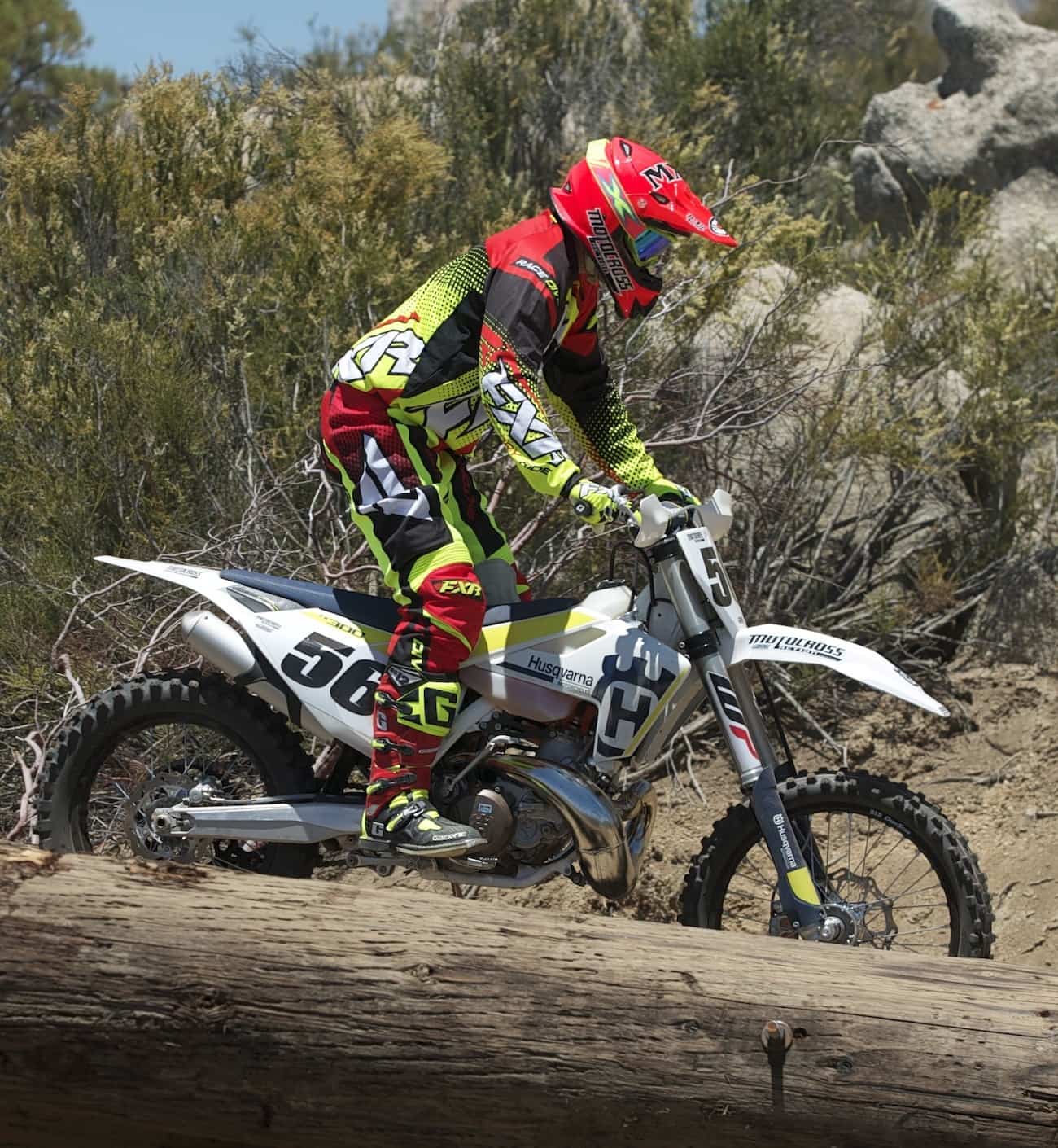





Comments are closed.